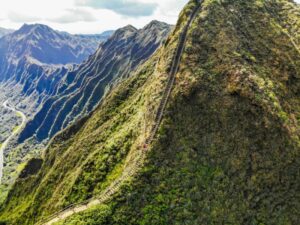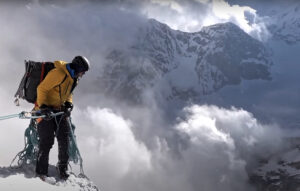On October 15, Swiss alpinist Silvan Schupbach freed a newly established multi-pitch trad line in the Bernese Alps. Christened Tradündition and graded 8b (5.13d), the route spears eight pitches of compact, colorful limestone and is believed to be Switzerland’s hardest multi-pitch trad line.
In a noteworthy nod to leave-no-trace ethos, Schupbach and co-conspirator Peter Von Kanel established a traditional multi-pitch climb on a limestone formation. Limestone is notoriously inhospitable to the secure placement of fall protection gear. This is perhaps the most impressive (and harrowing) takeaway from this climb.
Bernese Alps multi-pitch trad at its hardest

Eight-pitch Tradündition 8a (5.13d), FA’s by Schupbach, in Switzerland’s remote Bernese Alps. Photo: Silvan Schupbach
In spring 2020, Schupbach and Von Kanel discovered an untouched limestone wall on the west face of Dündenhorn (2,862m) in the Bernese Alps. The Swiss climbers began testing the potential of this undeveloped area, climbing various lines graded up to 6c (5.11a).
Then a year ago, the pair came across the project line. It was steep with overhanging features and a crack system. It took them one day to work through the prologue pitch. Afterward, they progressed through the penultimate seventh pitch, using the right-trending crack system to speed progress through part of the climb.
But owing to poor weather, Schupbach and Von Kanel could not equip the route with fixed ropes until this past September, with the help of several friends. With the fixed lines in place, Schupbach worked out the final pitch’s crux.
In mid-October, supported by Von Kanel, Schupbach redpointed all eight burly limestone pitches, establishing the final pitch during the send. The feat bagged a first free ascent and the first ascent of Tradündition in one fell swoop.
Limestone trad is rare

Peter Von Kanel on Tradündition. Photo: Vladek Zumr
Once exposed to the elements and repeated human contact, dense, hard limestone quickly takes on a polished finish. This issue is not as common with harder climbable rock like granite or sandstone, which maintains texture despite exposure. That durability lends grittier sedimentary rock to trad climbing: The texture helps secure and grip trad gear like cams and nuts.
Furthermore, it’s not as common to find a bomber crack feature in a limestone formation. Because of the rock’s silty composition, a crack feature often occurs only when the limestone is poor and crumbly — and no one wants to place gear or bolt a choss pile.
But that’s where Tradündition defies trad (and limestone) norms. It’s a colossal testament to no-bolt ethics, showing that not only can a limestone route go without bolts, but it can also continue in that way for eight pristine pitches. It might knock the challenge up a grade or two, but perhaps all it takes is a climber willing to figure it out.
Following his send in the Bernese Alps, Schupbach offered his insights to climbing without permanent equipment:
[I]t seems to me that in recent years a lot of routes have been set up along the lines of a climbing gym, and I hope that there are and always will be places where it’s the mountains that dictate whether there is pro and what it’s like. I believe that if as few traces as possible are made and that if the – little – in-situ gear is easy to remove/replace, a route retains much of its original wild nature and can be ‘discovered’ again and again.
Read Schupbach’s full report on his website, slack-line.ch.






